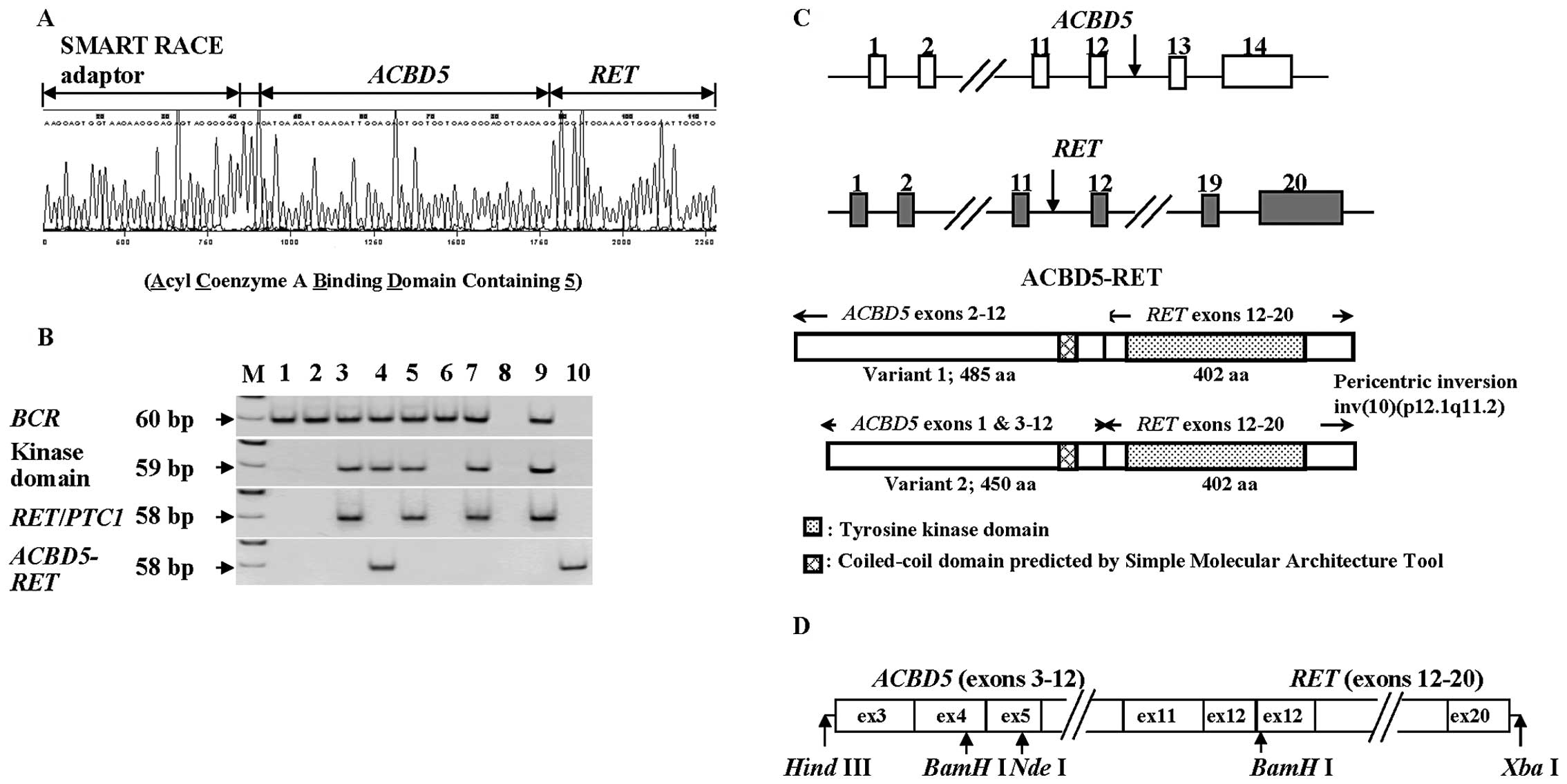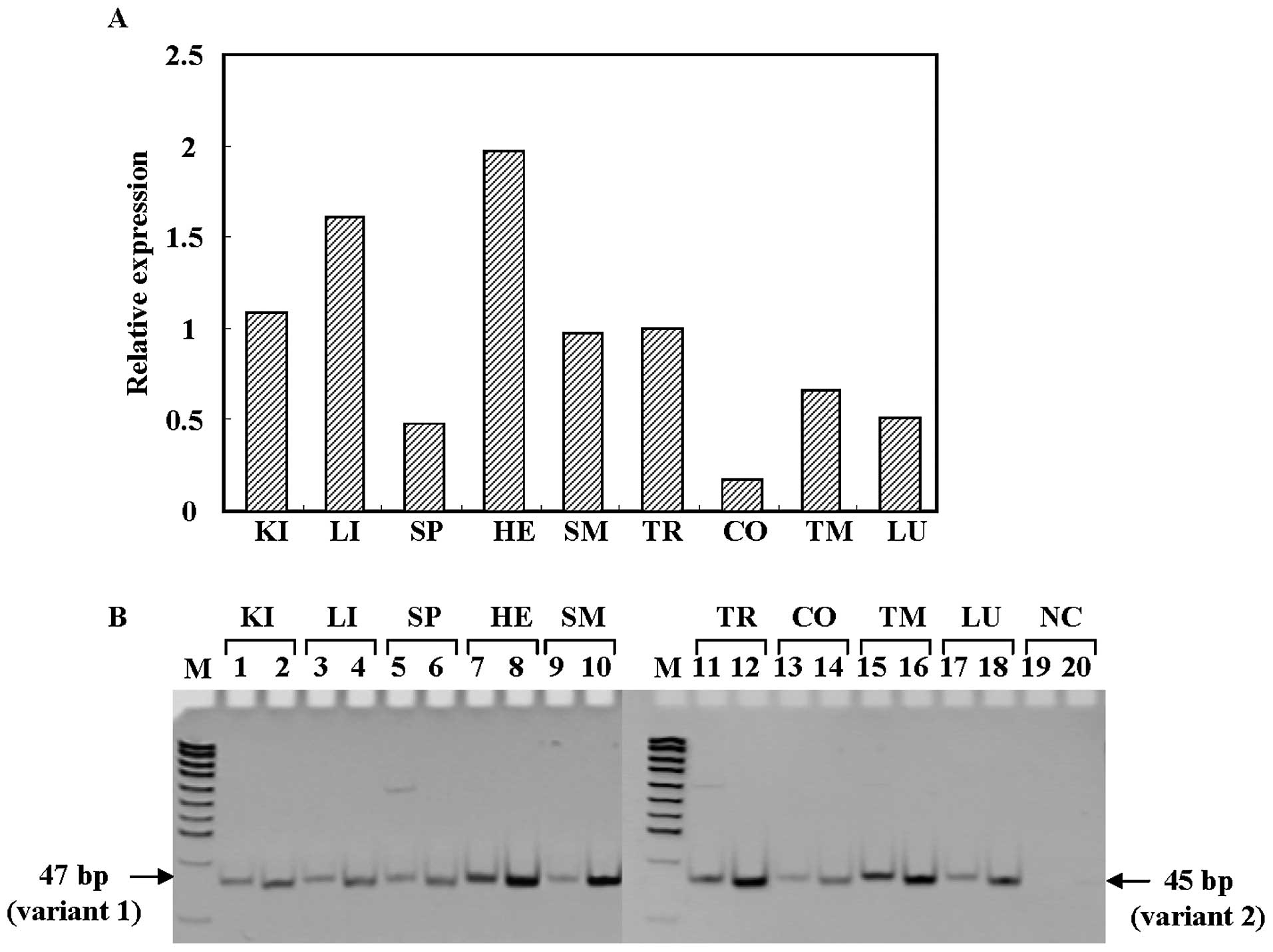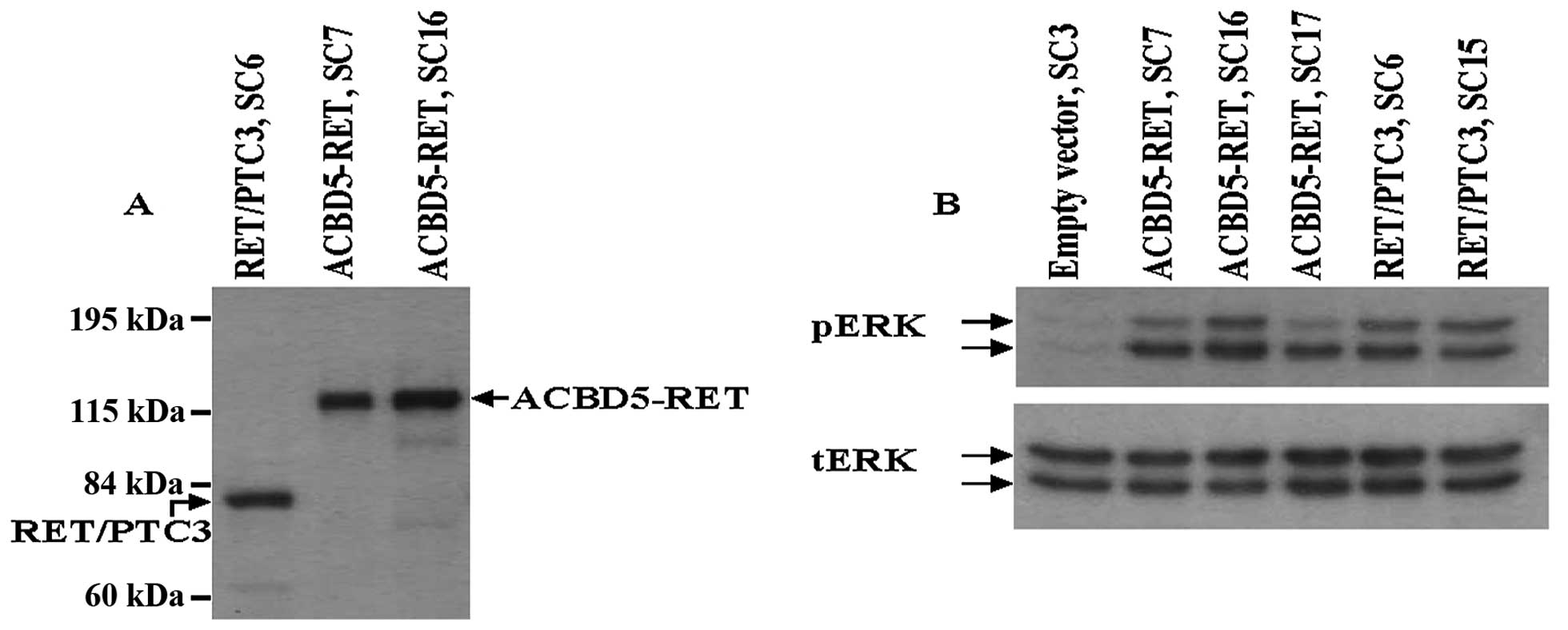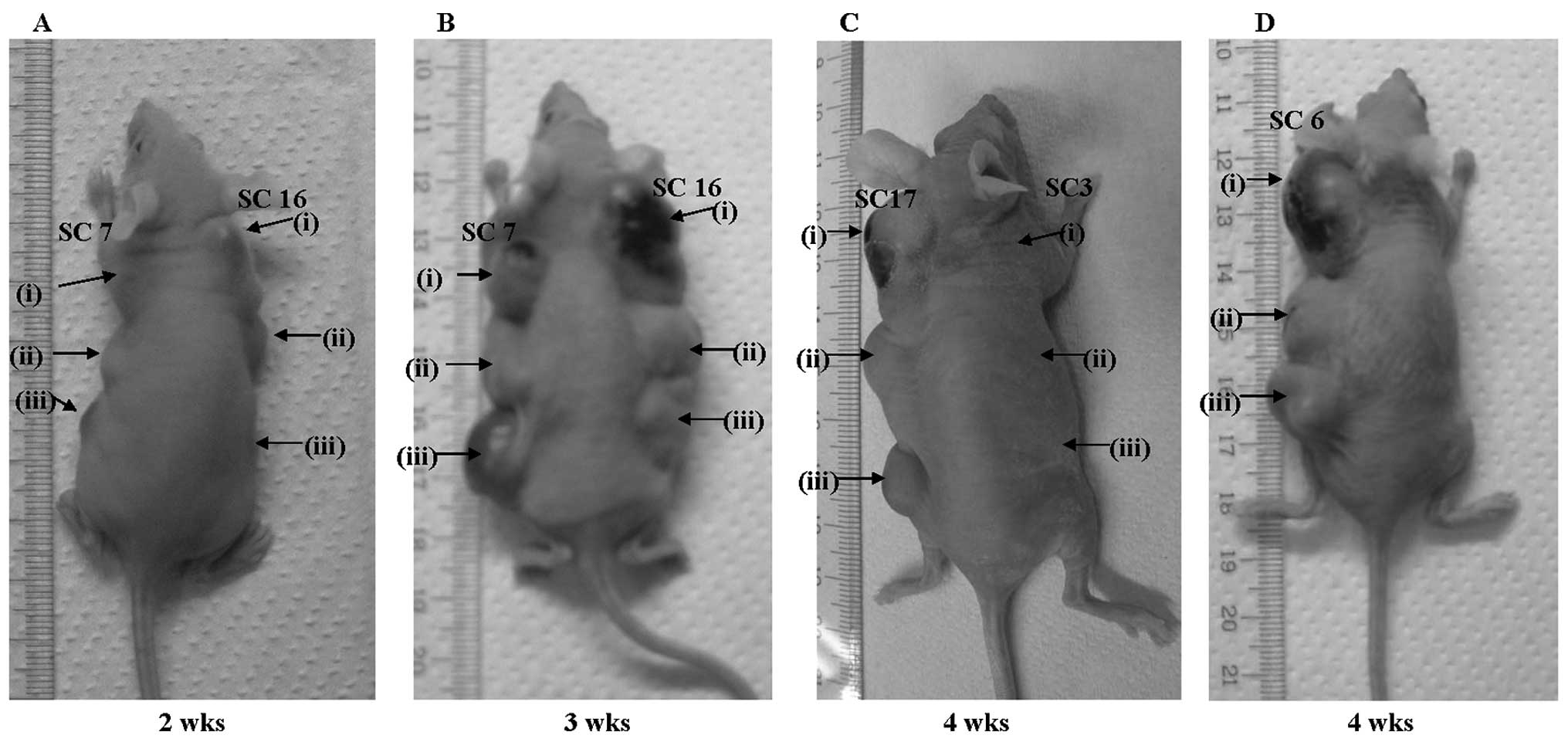A novel RET rearrangement (ACBD5/RET) by pericentric inversion, inv(10)(p12.1;q11.2), in papillary thyroid cancer from an atomic bomb survivor exposed to high-dose radiation
- Authors:
- Published online on: August 29, 2014 https://doi.org/10.3892/or.2014.3449
- Pages: 1809-1814
Abstract
Introduction
The RET proto-oncogene encodes a tyrosine kinase (TK) receptor protein that is expressed normally in neural crest-derived cells (1–3). In papillary thyroid cancer (PTC), the RET proto-oncogene fuses to sequences of the 5′ portion of partner genes at its TK domain via chromosomal inversion or translocation, resulting in rearranged and constitutively activated chimeric oncogenes called RET/PTC (4–7). To date, at least 15 different types of rearranged RET/PTC have been found, with 12 different partner genes (8–10). The majority of rearranged RET oncogenes found in PTC are RET/PTC1 and RET/PTC3, which are formed by paracentric inversions of chromosome 10. Most rare types of these RET rearrangements have been isolated from radiation-associated PTCs, such as those arising post-Chernobyl (10–17). All the partner genes of rearranged RET/PTC thus far identified are widely expressed in various human tissue including thyroid. The chimeric products of RET/PTC are constitutively expressed and form homo-dimers mediated by the coiled-coil domains of the partner genes in PTC, resulting in a ligand-independent activation of TK of the RET.
During molecular analyses of ~100 PTC cases from atomic bomb (A-bomb) survivors, rearrangements of genes with kinase domains, such as RET, NTRK1 and ALK, have frequently been detected in survivors exposed to high radiation doses (18,19). Among these, RET/PTC1 was the most common rearranged gene in the PTC cases examined in A-bomb survivors exposed to a radiation dose of >500 mGy. An improved rapid amplification of cDNA ends (RACE) method was established to identify unknown RET rearrangement with RNA extracted from archival formalin-fixed, paraffin-embedded (FFPE) thyroid cancer tissue specimens. Using this method, a PTC A-bomb survivor exposed to a high radiation dose was found to possess RET/PTC8 (20), which had been identified in thyroid cancer from post-Chernobyl children (14). In addition, a novel type of RET rearrangement, i.e., acyl-coenzyme A binding domain containing 5 (ACBD5)-RET, was found in a PTC from another high-dose A-bomb survivor. In the present study, we reported the identification and molecular characteristics of the ACBD-RET rearrangement that was formed by fusion of the tyrosine kinase domain of RET to the 5′ portion of ACBD5 gene located in the short arm of chromosome 10, via pericentric inversion inv(10)(p12.1;q11.2).
Materials and methods
Tissue specimens
FFPE PTC specimens from A-bomb survivors, preserved at room temperature for 20–50 years, were collected and analyzed with approval of the Human Investigation Committee, and the Ethics Committee for Genome Research at the Radiation Effects Research Foundation (RERF). A novel RET rearrangement (ACBD5-RET) was discovered in PTC specimen from one A-bomb survivor whose DS02 dose (21) was 1.8 Gy (weighted thyroid dose).
RNA extraction
RNA was isolated from dissected tissue using the High Pure RNA Paraffin kit according to the manufacturer’s instructions (Roche Diagnostics GmbH, Mannheim, Germany) with some modifications, as described in a previous study (22).
cDNA synthesis and improved switching mechanism at 5′ end of RNA transcript (SMART) RACE
cDNA synthesis and improved SMART RACE with RNA from archival FFPE PTC tissues was carried out as described in a previous study (20).
Cloning and sequencing of cDNA fragments of ACBD5-RET gene
Target candidate cDNA fragments derived from the second SMART RACE-PCR products were eluted from 8% acrylamide gel and cloned into HincII digested plasmid vector. Plasmid DNA containing an insert of >70 bp was sequenced using DNA sequencer CEQ8000 (Beckman Coulter Inc., Fullerton, CA, USA), since the total length of the SMART adaptor and the 5′ portion of exon 12 of RET was 55 bp.
RT-PCR detection of ACBD5-RET
RT-PCR was carried out as previously described (20). RT-PCR products were cloned in a cloning vector and confirmed as actual ACBD5-RET products by sequencing.
Determination of ACBD5 gene expression levels in normal tissue by real-time PCR
Human normal tissue RNAs were purchased from BioChain Institute, Inc. (USA). Total RNA (2 μg) was reverse transcribed with 100 units of ReverTra Ace (Toyobo Co., Japan) as described in a previous study (20). Quantitative PCR amplifications were carried out using ABsolute™ qPCR SYBR-Green Mixes according to the manufacturer’s instructions (Thermo Fisher Scientific Inc., USA). Amplification conditions optimized for the iCycler instrument (Bio-Rad, Hercules, CA, USA) resulted in a single PCR product, which was judged by using melting curve and electrophoretic analysis. 18SrRNA was used as a reference. The assays were run in duplicate using the following primer set: ACBD5-RT56F, 5′-GCCATGATTGCATATGTTGA AG-3′ and ACBD5-RT56R, 5′-AACTCCTGCCACTCTTTT TGTC-3′ for ACBD5 gene; and 18SrRNART-F12, 5′-GTAG TCGCCGTGCCTACCAT-3′ and 18SrRNART-R12, 5′-GTTTCTCAGGCTCCCTCTCC-3′ for 18SrRNA.
Expression of variant 1 and 2 of ACBD5 gene in normal tissue by RT-PCR
RT-PCR of variant 1 and 2 of ACBD5 gene was carried out as described elsewhere (20). Briefly, the primer sets used were: ACBD5ex2F2, 5′-TCTTCTGCTAGACATGCTC TTCCT-3′ and ACBD5ex3R1, 5′-CCCAAGAGCCTGCATG AAAC-3′ for variant 1; and ACBD5ex1F2, 5′-GACAGGCCT TGTCCGGCAATA-3′ and ACBD5ex3R1, 5′-CCCAAGAGC CTGCATGAAAC-3′ for variant 2. The cDNA derived from 2 ng of total RNA was used as a template for RT-PCR. PCR conditions consisted of initial denaturation (95°C for 2 min), followed by 36 cycles (denaturation at 95°C for 30 sec, annealing at 60°C for variant 2 or 62°C for variant 1, for 30 sec, extension at 72°C for 30 sec), and final extension at 72°C for 3 min.
Construction of ACBD5-RET
Total RNA from the PTC cell line TPC1 was used to amplify RET/PTC1 using a sense primer (H4PRTF1, TTAAGCTTCTGCTGCTCCTCCTCCT TTCCA) located in the 5′ flanking region of H4 gene and an antisense primer (RET-3′ end R3, AATCTAGATCAGGGGTA GTGGCTGCTCAGTA) located in the 3′ untranslated region of RET gene. After digestion of amplified fragments with HindIII and XbaI, a fragment of ~2,400 bp was inserted into HindIII and XbaI-digested pBluescript II SK(−). To replace the partner of RET/PTC1 with 5′ region of ACBD5 gene, a fragment of ~1,200 bp covering the region from exon 5 to exon 12 of the ACBD5 gene was amplified with total RNA from human normal thymus using sense primer ACBD5F2, TTAA GCTTAATGGGATGCTTGGAGTTCACTG, located in the joint region of exons 4 and 5 of ACBD5 gene, and antisense primer ACBD5-RETR1, CTTTGGATCCTCCTGTGAGG TGGGCTGAGGAGCA, which corresponds to regions of 3′ end of exon 12 of ACBD5 and of 5′ end of exon 12 of RET. Following digestion with HindIII and BamHI, a fragment of ~1,200 bp was inserted into HindIII and BamHI-digested pBluescript II SK(−) containing BamHI-XbaI fragment of RET kinase domain. To complete the construction of ACBD5-RET, a fragment of ~500 bp containing the region from initiation codon to exon 5 of ACBD5 gene was amplified with total RNA from human normal thymus using sense primer ACBD5F1, ACAACAAGCTTTCATGCAGGCTCTTGGGAAAGC, and antisense primer ACBD5R2, CGGTTTTGGCGTTCGGA GTAGA. After digestion of the amplified fragments with HindIII and NdeI, whose recognition site is located in exon 5 of ACBD5 gene, the digested fragments were ligated to HindIII- and NdeI-digested pBluescript II SK(−) containing regions of exons 4–12 of ACBD5 and exons 12–20 of RET. Underlined primers indicate the restriction enzyme sites that were artificially created to make the construct of ACBD5-RET.
DNA transfection
NIH3T3 cells (5×104) were transfected with 10 μg of empty vector, ACBD5-RET or RET/PTC3 expression vectors (pcDNA3.1) (Invitrogen, Carlsbad, CA, USA) using FuGENE6 Transfection Reagent (Roche Diagnostics GmbH). After 2 days, cells were further incubated in DMEM containing 10% calf serum and 500 μg/ml of G418. G418-resistant colonies were screened for transfected cDNA expression by RT-PCR. Selected clones were then analyzed for phosphorylation of ERK protein by western blotting.
Western blot analysis
After scraping out the cells from 100 mm dishes, 1×106 stable transfectants were lysed in 100 μl of RIPA lysis buffer (Merck Millipore Co., Germany). After adding 2X SDS buffer to cell lysate, and heating at 95°C, an aliquot (~2 μg of proteins) was separated by 8% SDS-polyacrylamide gel and then transferred to a PVDF membrane. Specific bands were detected by incubating with primary antibodies and then with horseradish peroxidase-conjugated anti-rabbit antibody (Cell Signaling Technology Co., USA), and finally by treatment with enhanced chemiluminescence reagent (Amersham Biosciences). For analysis of RET protein, Ret (C31B4) rabbit monoclonal antibody (Cell Signaling Technology Co.) was used as the primary antibody. Phospho-p44/42 MAP kinase antibody and p44/42 MAP kinase antibody (Cell Signaling Technology Co.) were used as primary antibodies for analysis of phosphorylation of ERK1/2.
Transformation assay
Stable transfectants were suspended at a cell concentration of 2×106/ml in culture media and injected subcutaneously into the flank of BALB/c nu/nu female mice. Three clones of stable transfectants with ACBD5-RET and one clone of stable transfectants with RET/PTC3 and G418-resistant NIH3T3 cells with empty vector were injected into one flank of the mice at different cell densities (1×106, 5×105 and 2.5×105 cells). Animal experiments in this study were conducted on the basis of approval from the RERF’s Experimental Animal Care Committee.
Results and Discussion
Identification and expression of ACBD5-RET gene in PTC of one A-bomb survivor exposed to high-dose radiation
During analysis of RET/PTC rearrangements in PTC specimens among A-bomb survivors, a cDNA fragment of a new type of RET/PTC, with a size of 102 bp, was isolated from one A-bomb survivor exposed to 1.8 Gy using the improved RACE method (20) in PTC. Sequence analysis revealed that the isolated fragments contained a portion of exon 12 of the ACBD5 gene that was fused in frame with exon 12 of the RET gene (Fig. 1A). The fragment obtained from the 5′ SMART RACE method contained an unknown insert of 3 bp (GGA) between the adaptor for RACE and ACBD5; RT-PCR-amplified fragments covering the corresponding region did not include any 3 bp-insert (GGA), and were coincident with sequences of the reported ACBD5 (data not shown). The 3 bp-insert was presumably derived from the template-independent addition of a few nucleotides by terminal transferase activity of reverse transcriptase in the process of SMART RACE.
The ACBD5-RET chimera gene was detected only in PTC from this A-bomb survivor by RT-PCR with gene-specific primers (Fig. 1B). Since the tissue samples used were specimens that had been fixed with unbuffered formalin, embedded in paraffin and preserved for >40 years (resulting in vigorous degradation of RNA), we were unable to clone a full-length cDNA of the ACBD5-RET gene using either 5′ RACE method or RT-PCR. However, the ACBD5 gene is ubiquitously expressed in various normal human tissues including thyroid, with two major products, variants 1 and 2 (Fig. 2A and B). The former starts from exon 2, while the latter starts at exon 1 and skips exon 2 (Fig. 1C). When we compared the expression levels of variants 1 and 2 of the ACBD5 gene in various human tissues, we found that expression levels of variant 2 of ACBD5 gene were higher than those of variant 1 in normal thyroid (Fig. 2B). Assuming that the ACBD5-RET fusion gene utilized an initiation codon in exon 3 of the ACBD5 gene, as is the case for variant 2 of ACBD5, we prepared a construct of the ACBD5-RET gene (Fig. 1D), as described in the Materials and methods section.
Activation of MAPK pathway in ACBD5-RET-introduced NIH3T3 stable transfectants
Since RET/PTC fusion gene products are involved in cell growth through phosphorylation of ERK protein, we evaluated the ability of the ACBD5-RET protein to phosphorylate ERK protein using stable transfectants of NIH3T3 cells constitutively expressing ACBD5-RET. Expression of ACBD5-RET or RET/PTC3 proteins in these stable transfectants is shown in Fig. 3A. Enhanced ERK protein phosphorylation was observed in three different transfectants: SC7, SC16 and SC17; and phosphorylation levels were comparable to those of two NIH3T3 stable transfectants with RET/PTC3, SC6 and SC15 (Fig. 3B). In RET/PTC fusion proteins, oligomerization is mediated by coiled-coil domains of the partner gene of RET/PTC genes, resulting in constitutive activation of tyrosine kinase through autophosphorylation of critical tyrosine residues in the RET/PTC genes (23). Enhanced phosphorylation of ERK in the stable transfectants with ACBD5-RET would result from the ligand-independent activation of tyrosine kinase by homodimerization of this chimera-protein through coiled-coil region located on exon 10 of ACBD5 gene, which was predicted by simple molecular architecture tool (EMBL).
Transforming activity of ACBD5-RET in NIH3T3 stable transfectants
To assess the tumorigenic activity of ACBD5-RET, we conducted a tumor formation assay in nude mice, using three clones (SC7, SC16 and SC17) from ACBD5-RET-introduced NIH3T3 stable transfectants. Administration of 1×106 of each stable transfectant with ACBD5-RET resulted in tumor formation in nude mice as early as 10 days after injection. Detectable tumors formed in nude mice two weeks after injection of 5×105 or 2.5×105 cells (Fig. 4A). In all three clones, tumors grew to >15 mm 3–4 weeks after injection of each cell dilution (Fig. 4B and C). NIH3T3 stable transfectants, with RET/PTC3 used as positive control, also formed detectable tumors 2–4 weeks after injection (Fig. 4D). By contrast, no tumors were detected even 4 weeks after injection of 0.25–1×106 of NIH3T3 cells with empty vectors (Fig. 4C). These results suggest that ACBD5-RET gene products may function as oncogene by constitutively activating MAP kinase through their homodimerization, as do products of other RET/PTC genes (23–25).
Acknowledgements
The Radiation Effects Research Foundation (RERF), Hiroshima and Nagasaki, Japan, is a public interest foundation funded by the Japanese Ministry of Health, Labour and Welware (MHLW), and the US Department of Energy (DOE). This study was funded in part through DOE award DE-HS0000031 to the National Academy Sciences, and in part by a Grant-in-Aid for Science Research from the Ministry of Education, Culture, Sports, Science and Technology, and a Grant-in Aid for Cancer Research from the Ministry of Health, Labour and Welfare of Japan, as well as a Research Grant for the Princess Takamatsu Cancer Research Fund (08-24015). This publication was supported by RERF Research Protocols RP 5-02. The views of the authors do not necessarily reflect those of the two governments.
References
|
Pachinis V, Mankoo B and Costatini F: Expression of the c-ret proto-oncogene during mouse embryogenesis. Development. 19:1005–1017. 1993. | |
|
Avantaggiato V, Dathan NA, Griero M, Fabien N, Lazzaro D, Fusco A, Simeone A and Santoro M: Developmental expression of the RET protooncogene. Cell Growth Differ. 5:305–311. 1994. | |
|
Schuchardt A, D’Agati V, Larsson-Blomberg L, Costantini F and Pachnis V: Defects in the kidney and enteric nervous system of mice lacking the tyrosine kinase receptor Ret. Nature. 367:380–383. 1994. View Article : Google Scholar : PubMed/NCBI | |
|
Grieco M, Santoro M, Berlingieri MT, Melillo RM, Donghi R, Bongarzone I, Pierotti MA, Della Porta G, Fusco A and Vecchio G: PTC is a novel rearranged form of the ret proto-oncogene and is frequently detected in vivo in human thyroid papillary carcinomas. Cell. 60:557–563. 1990.PubMed/NCBI | |
|
Bongarzone I, Monzini N, Borrello MG, Carcano C, Ferraresi G, Arighi E, Mondellini P, Della Porta G and Pierotti MA: Molecular characterization of a thyroid tumor-specific transforming sequence formed by the fusion of ret tyrosine kinase and the regulatory subunit RI alpha of cyclic AMP-dependent protein kinase A. Mol Cell Biol. 13:358–366. 1993. | |
|
Bongarzone I, Butti MG, Coronelli S, Borrello MG, Santoro M, Mondellini P, Pilotti S, Fusco A, Della Porta G and Pierotti MA: Frequent activation of ret protooncogene by fusion with a new activating gene in papillary thyroid carcinomas. Cancer Res. 54:2979–2985. 1994.PubMed/NCBI | |
|
Santoro M, Dathan N, Berlingieri MT, Bongarzone I, Paulin C, Grieco M, Pierotti MA, Vecchio G and Fusco A: Molecular characterization of RET/PTC3; a novel rearranged version of the RET proto-oncogene in a human thyroid papillary carcinoma. Oncogene. 9:509–516. 1994. | |
|
Tallini G and Asa SL: RET oncogene activation in papillary thyroid carcinoma. Adv Anat Pathol. 8:345–354. 2001. View Article : Google Scholar : PubMed/NCBI | |
|
Arighi E, Borrello MG and Sariola H: RET tyrosine signaling in development and cancer. Cytokine Growth Factor Rev. 16:441–467. 2005. View Article : Google Scholar : PubMed/NCBI | |
|
Ciampi R, Giordano TJ, Wikenheiser-Brokamp K, Koenig RJ and Nikiforov YE: HOOK3-RET: a novel type of RET/PTC rearrangement in papillary thyroid carcinoma. Endocr Relat Cancer. 14:445–452. 2007. View Article : Google Scholar | |
|
Fugazzola L, Pierotti MA, Vigano E, Pacini F, Vorontsova TV and Bongarzone I: Molecular and biochemical analysis of RET/PTC4, a novel oncogenic rearrangement between RET and ELE1 genes, in a post-Chernobyl papillary thyroid cancer. Oncogene. 13:1093–1097. 1996. | |
|
Klugbauer S, Demidchik EP, Lengfelder E and Rabes HM: Detection of a novel type of RET rearrangement (PTC5) in thyroid carcinomas after Chernobyl and analysis of the involved RET-fusion gene RFG5. Cancer Res. 58:198–203. 1998.PubMed/NCBI | |
|
Klugbauer S and Rabes HM: The transcription coactivator HTIF1 and a related protein are fused to the RET receptor tyrosine kinase in childhood papillary thyroid carcinomas. Oncogene. 18:4388–4393. 1999. | |
|
Klugbauer S, Jauch A, Lengfelder E, Demidchik E and Rabes HM: A novel type of RET rearrangement (PTC8) in childhood papillary thyroid carcinomas and characterization of the involved gene (RFG8). Cancer Res. 60:7028–7032. 2000. | |
|
Salassidis K, Bruch J, Zitzelsberger H, Lengfelder E, Kellerer AM and Bauchinger M: Translocation t(10;14)(q11.2:q22.1) fusing the kinetin to the RET gene creates a novel rearranged form (PTC8) of the RET proto-oncogene in radiation-induced childhood papillary thyroid carcinoma. Cancer Res. 60:2786–2789. 2000. | |
|
Corvi R, Berger N, Balczon R and Romeo G: RET/PCM-1: a novel fusion gene in papillary thyroid cancer. Oncogene. 19:4236–4242. 2000. View Article : Google Scholar | |
|
Saenko V, Rogounovitch T, Shimizu-Yoshida Y, Abrosimov A, Lushnikov E, Roumiantsev P, Matsumoto N, Nakashima M, Merimanov S, Ohtsuru A, Namba H, Tsyb A and Yamashita S: Novel tumorigenic rearrangement, Δ rfp/ret, in a papillary thyroid carcinoma from externally irradiated patient. Mutat Res. 527:81–90. 2003. | |
|
Hamatani K, Eguchi E, Ito R, Mukai M, Takahashi K, Taga M, Imai K, Cologne J, Soda M, Arihiro K, Fujihara M, Abe K, Hayashi T, Nakashima M, Sekine I, Yasui W, Hayashi Y and Nakachi K: RET/PTC rearrangements preferentially occurred in papillary thyroid cancer among atomic bomb survivors exposed to high radiation dose. Cancer Res. 68:7176–7182. 2008. View Article : Google Scholar | |
|
Hamatani K, Mukai M, Takahashi K, Hayashi Y, Nakachi K and Kusunoki Y: Rearranged anaplastic lymphoma kinase (ALK) gene in adult-onset papillary thyroid cancer amongst atomic bomb survivors. Thyroid. 22:1153–1159. 2012.PubMed/NCBI | |
|
Hamatani K, Eguchi H, Taga M, Mukai M, Koyama K, Hayashi Y and Nakachi K: Improved method for analysis of RNA present in long-term preserved thyroid cancer tissue of atomic-bomb survivors. Thyroid. 20:43–49. 2010. View Article : Google Scholar : PubMed/NCBI | |
|
Young RW and Kerr GD: Reassessment of the Atomic Bomb Radiation Dosimetry for Hiroshima and Nagasaki - Dosimetry System 2002. 1. Radiation Effects Research Foundation; Hiroshima, Japan: 2005 | |
|
Hamatani K, Eguchi H, Takahashi K, Koyama K, Mukai M, Ito R, Taga M, Yasui W and Nakachi K: Improved RT-PCR amplification for molecular analyses with long-term preserved formalin-fixed, paraffin-embedded tissue specimens. J Histochem Cytochem. 54:773–780. 2006. View Article : Google Scholar | |
|
Tong Q, Xing S and Jhiang SM: Leucine zipper-mediated dimerization is essential for the PTC1 oncogenic activity. J Biol Chem. 272:9043–9047. 1997. View Article : Google Scholar : PubMed/NCBI | |
|
Alberti L, Carniti C, Miranda C, Roccato E and Pierotti M: RET and NTRK1 proto-oncogenes in human diseases. J Cell Physiol. 195:168–186. 2003. View Article : Google Scholar : PubMed/NCBI | |
|
Kodama Y, Asai N, Kawai K, Jijiwa M, Murakumo Y, Ichihara M and Takahashi M: The RET proto-oncogene: a molecular therapeutic target in thyroid cancer. Cancer Sci. 96:143–148. 2005.PubMed/NCBI |













